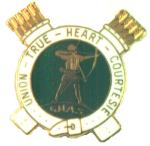
In the middle of discussing the contribution of genetic and evolutionary knowledge to what she was calling "ecological wisdom," she showed a color version of this drawing showing the bone structure of a bat wing, whale flipper, horse leg, and human hand. The label was "Convergent Evolution."
My colleague went on to say that ecology draws from evolution the message that life often solves the same problem in the same way -- that many different life forms have evolved the same solution to the same problem.
Suddenly it all came flooding back to me. I had seen a previous version of this slideshow the last time the course was taught, and this slide was present. At the time I felt a shiver of dread. The label and description were wrong. The bone structures of mammalian forelimbs are an example of homology -- the reconfiguration of a common skeletal formation into several different shapes by lengthening, shortening, and changing the angle of the bones. Although the flipper and the hand, for example, look very different, underneath it's the same number and configuration of bones.
Convergent evolution, what my colleague was describing, would be better illustrated by a slide of a bat wing and a bird wing. Mammals and birds evolved flight separately, and both independently developed the wing structure to achieve it.
When I saw the slide last year, I made a mental note to speak about it to another of my colleagues, one who specializes in scientific scholarship. And I did, later that same day. "We need to let Mutual Colleague know that she's not using that slide correctly," I said, and he agreed.
Obviously we failed. Neither of us ever mentioned it to her, and here was the slide again and the accompanying narration again (it appears twice in the presentation to my increasing distress).
Why didn't we say something? Why have I still not said something, having seen the mistake repeated? Because it's hard to correct a colleague. When you're up at the podium giving a lecture with several other professors in attendance, the pressure to be accurate and insightful is enormous. You feel a gnawing fear that your notes are riddled with errors, that every improvised aside is a potential misstep, that the fact or interpretation you just dredged up from the muck of some lecture you yourself heard years ago was discredited last week with great fanfare, and no one told you.
It's a vulnerable position. And I hesitate to undermine a colleague's authority, even in private. Plus, correcting her feels painfully close to criticizing her. It's an elevation of my knowledge over hers in a field that is far away from my expertise and closer to hers. It's just a very uncomfortable thing to do.
Yet my failure to do it means that the incorrect slide and the incorrect information went out to another 150 students today. Some of them probably knew -- or suspected -- that it wasn't right. Maybe they wrote it off as an honest mistake (though given the repeated explanation, it's hard to see it as anything but incorrect understanding). Maybe they looked at the rest of her presentation with more skepticism given this fundamental error. And maybe the rest of them, the ones who didn't know better, now have a muddled set of terms and images in their heads that I can never eradicate.
Or maybe nobody was paying that close attention and it's no big deal. But I can't help feeling anxiety about it -- both about the error, and about my failure to prevent its repeat dissemination. I'm sure I make lots of errors in my lectures, and I don't want -- but I need -- people who know better to correct me. How to do it without doing damage to already-fragile relationships, though, is beyond me.





6 comments:
Anonymous notes? Cowardly, but more comfortable for all sides.
A similar sort of thing happened to me in an Art History/Music class. My professor was lecturing on Samuel Coleridge Taylor, an Afro-British, early-20th century composer and conductor. She proclaimed to the class that not only had Taylor been a pioneer as a conductor, he had also written "The Rime of the Ancient Mariner."
Music isn't my field, but English Literature is, and the guy who wrote that poem was white, fat, and dead before 1840. And in his name, the 'Coleridge' came last.
But it's very hard to correct a professor (for me at least), in class or out, and I didn't say anything. I did, however, stew about it for weeks.
Egads, do you just want your biologically inclined readers to break out in hives?
Those two terms are commonly confused by students, though I am surprised a science professor would make that error. But absolutely, yes, you'd be doing the person a favor by setting them straight. I'd try to get anther science professor to do it, perhaps by sending her some other suggestions for visual aides. The "when I lecture on that topic, students often confuse those concepts; here's an illustration I've found that seems to clarify it for them" approach.
Thought of another reasonable way of "framing" your concerns. Jonathan Wells' obnoxious and inaccurate book The Icons of Evolution uses homology as one of its examples of classic textbook illustration that is wrong and being used to misleading students into believing evolutionary theory. Since many of your students have undoubtedly encountered this propaganda in their churches, and these aprticular concepts are so easily confused, it's important that they get a crystal-clear definition in class to help keep them from falling for Wells' "circular argument" ruse.
Maybe this link would help?
http://www.ncseweb.org/icons/icon3homology.html
Write an uber-nice note where you pretend to be an entomology student saying that you happened to see the same slide under a different label one time and slide it under her door. :)
Don't I know it...
Whether it comes from you or not, I hope you're able to get the proper feedback to this person. Nobody's receiving any favors, including yourself, from silence. But yeah, these sort of things can be awfully tricky.
Maybe you could phrase it as a question or request for clarification? Do the students have a textbook that defines the terms more clearly? I do think it needs to be corrected.
Post a Comment